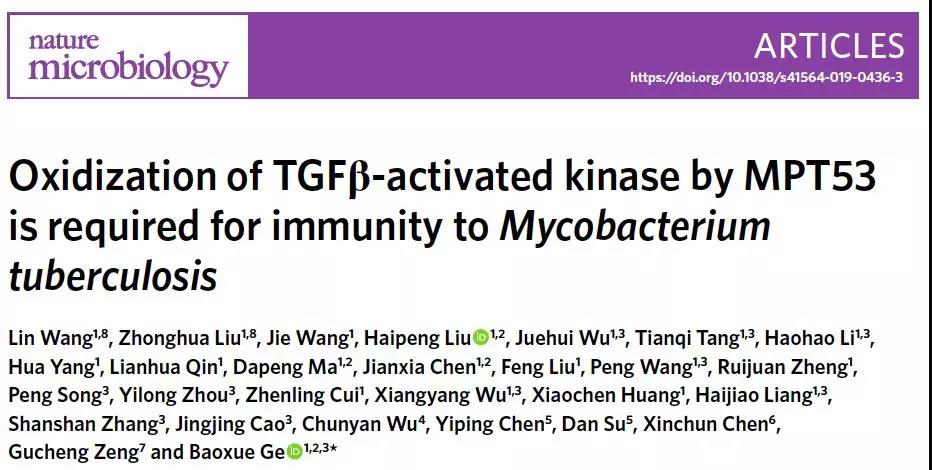The Mycobacterium tuberculosis infection
remains one of the leading reasons causing human beings to die of infection.
According to the World Health Organization(WHO), there were one million and six
hundred thousand mortalities of over ten million new cases through out the
world in 2017[1]. Previous researches found that various
ingredients of mycobacterium tuberculosis (Mtb) could be recognized by the pattern
recognition receptor of innate immune cells in host and activate the downstream
inflammatory immune responses. Mycobacterium tuberculosis are able to use many
sorts of secretion system to make large amounts of proteins pass through the
hydrophobic bacteria wall structure and be secreted out, while whether these
secreted proteins will be recognized or not and the specific recognition
mechanism are not clear yet.
On May 21, 2019, Ge Baoxue’s research team
from Shanghai Pulmonary Hospital affiliated to Tongji University published the
article named Oxidization
of TGFβ-activated kinase by MPT53 is required for immunity to Mycobacterium
tuberculosis in Nature Microbiolog,which revealed that Mycobacterium
tuberculosis secretory
proteins MPT53 (Rv2878c) can directly combine with the host signal molecules
TAK1 (TGF -β- activated kinase 1) and facilitate TAK1 to build disulfide bond
formation with its sulfur oxido-rdeuctase activity, so as to promote the
interaction between TRAFs and TAB1 molecular with TAK1 and therefore activate TAK1
and the downstream inflammatory pathways. This research provide new ideas for the
host signal molecular perception of mycobacterium tuberculosis infection and
become theoretical support of the future tuberculosis vaccine development.

To explore the influence of mycobacterium tuberculosis
secretory proteins to the innate immune signaling pathways in host, they screened
more than 200 secretory proteins and lipoproteins of tuberculosis bacterium by
function with HEK293T cells luciferase reporter gene system, and the results
showed that secretory protein MPT53 can significantly activate the NF-κB and
AP-1 inflammatory signal paths. At the same time, the activity of MAPKs and NF-κB signaling pathways activated
by bacterium tuberculosis were found declined in both macrophages and lung
tissues of mice with H37Rv infection after knocking out MPT53, and the level of
inflammatory factor also become lower.
Presently the inflammatory factors induced by
mycobacterium tuberculosis are known to be produced mainly by TLR signal paths [2, 3].Researchers’ further study revealed that MPT53 has
interaction with the key signal molecular TAK1 protein kinase in TLR signal
pathway. Researchers found that the existence of MPT53 can significantly increase
the TAK1 kinase activity in both HEK293T cell overexpression system and
macrophage infection model. Through analyzing the structure and comparing sequence,
MPT53 protein has typical sulfur oxidation-reduction function area, and after
mutating the activate site, MPT53 can’t increase TAK1 kinase activity and
activate downstream inflammatory signal pathways. Further research showed that
MPT53 could oxidize C210 of TAK1, causing it to form disulfide bond and
facilitating TRAFs and TAB1 to form activated complex with TAK1.At last, researchers
built the recombinant
Mycobacterium Smegmatis which
overexpresses MPT53 (Ms-MPT53), they found that Ms-MPT53 could protect the host
from the pathological damage of lung tissue caused by mycobacterium tuberculosis
and reduce the Bacterium
load of the lung.
The recognition of mycobacterium tuberculosis is the
key step for host to start immune response, while mycobacterium tuberculosis
could secrete a large number of proteins to the outside of the bacteria [4], and now we all think that most secretory proteins
can inhibit the innate immune response of host and promote the pathogenicity of
mycobacterium tuberculosis infection, which help mycobacterium tuberculosis achieve
the goal of immune escape. But the study found that the molecular
characteristics of sulfur oxidation reduction function area in secretory
proteins MPT53 could be recognized by the host TAK1 protein kinase and activate
one inflammatory immune response pathway that doesn’t rely on receptors, which is
the restriction factors of the disease morbidity of mycobacterium tuberculosis
infection, and it also to provides more theoretical basis for the function of
mycobacterium tuberculosis secretory proteins.
It’s reported that Doctor Wang Lin and assistant
researcher Liu Zhonghua, from Shanghai Pulmonary Hospital affiliated to Tongji University,
are co-first author of this paper. And professor Ge Baoxue, from TUSM and Shanghai
Pulmonary Hospital affiliated to Tongji University, is the corresponding author.
Professor Ge Baoxue is Director of Shanghai Key Lab of Tuberculosis which is approved
to establish by the Shanghai Committee of Science and Technology in 2004, focuses
on basic and clinical translational research of tuberculosis prevention,
diagnosis and therapy, relies on Shanghai Pulmonary Hospital affiliated to
Tongji University. This research attained strong supports of Prof. Chen Zhijian
from the Southwestern Medical Center of Texas University, Doctor Lv liangDong from
Fudan University and researcher Mi KaiXia from the Key Laboratory of Pathogenic
Microorganisms and Immunology of Chinese Academy of Science.
Link: https://doi.org/10.1038/s41564-019-0436-3
Reference:
[1] World Health Organization. WHO Global Tuberculosis
Report 2018 (WHO, 2018).
[2] Liu, C. H., Liu, H. & Ge, B. Innate immunity
in tuberculosis: host defense vs pathogen evasion. Cell. Mol. Immunol. 14,
963–975 (2017).
[3] Stamm, C. E., Collins, A. C. & Shiloh, M. U.
Sensing of Mycobacterium tuberculosis and consequences to both host and
bacillus. Immunol. Rev. 264, 204–219 (2015).
[4] Abdallah, A. M. et al. Type VII
secretion—mycobacteria show the way. Nat. Rev. Microbiol. 5, 883–891 (2007).
